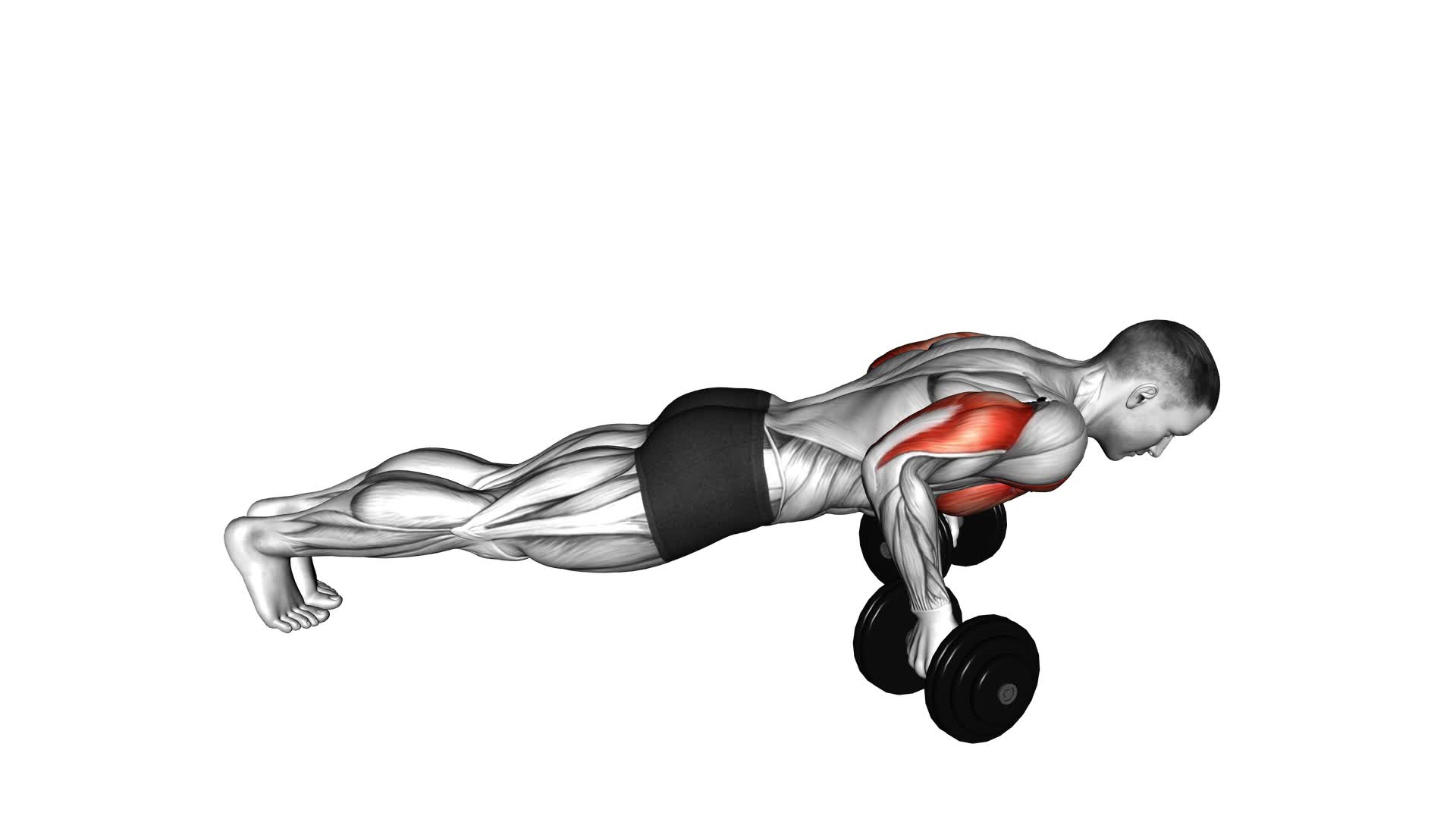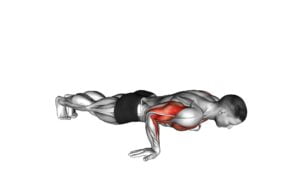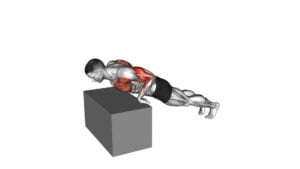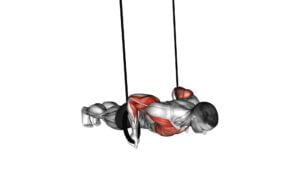Dumbbell Reverse Push-up – Video Exercise Guide & Tips

Are you looking to add a challenging exercise to your workout routine? The dumbbell reverse push-up may be just what you need.
Watch This Exercise Video
This exercise targets your upper body and core, helping to strengthen and tone your muscles. With the help of a dumbbell, you can take your push-up game to the next level.
In this video exercise guide, we will walk you through the proper form, variations, and common mistakes to avoid.
Get ready to take your fitness to new heights with the dumbbell reverse push-up.
Key Takeaways
- Targets multiple muscle groups simultaneously
- Improves upper body strength and stability
- Can be modified for different fitness levels
- Engages core muscles for stability and balance
Benefits of the Dumbbell Reverse Push-up
Discover the numerous benefits you can experience from incorporating the dumbbell reverse push-up into your workout routine.
The dumbbell reverse push-up is a versatile exercise that offers several advantages. One of the main benefits is that it targets multiple muscle groups simultaneously, making it an efficient full-body exercise. By engaging your chest, shoulders, triceps, and core muscles, this exercise helps to improve upper body strength and stability.
Another advantage of the dumbbell reverse push-up is that it can be modified to suit different fitness levels. Beginners can start with lighter dumbbells or no weights at all, gradually increasing the resistance as they become stronger. On the other hand, advanced individuals can use heavier dumbbells or incorporate additional variations such as single-arm or alternating arm movements to further challenge their muscles.
Additionally, the dumbbell reverse push-up can also help improve posture. By strengthening the muscles in your upper back and shoulders, it can help counteract the negative effects of prolonged sitting or poor posture. This exercise also engages your core muscles, promoting stability and balance.
Equipment Needed for the Exercise
To perform the dumbbell reverse push-up, you'll need a set of dumbbells of your preferred weight. Here are some discussion ideas regarding the equipment needed for this exercise:
- Recommended weights for the exercise:
- Beginners: Start with lighter dumbbells, around 5-10 pounds, to ensure proper form and technique.
- Intermediate: Gradually increase the weight to 10-20 pounds as you build strength and confidence.
- Advanced: Use heavier dumbbells, ranging from 20-30 pounds or more, to challenge your muscles and maximize the effectiveness of the exercise.
- Alternatives to dumbbells for the reverse push-up:
- Kettlebells: If you don't have dumbbells, kettlebells can be a suitable alternative. They provide a similar grip and resistance for the exercise.
- Water bottles: Fill two water bottles with sand or water to create makeshift weights. While not as sturdy as dumbbells, they can still provide some resistance for the exercise.
- Resistance bands: Attach resistance bands to a sturdy anchor point and hold the handles to simulate the motion of a reverse push-up. This option is great for those who prefer bodyweight exercises or have limited space.
Now that you know the equipment needed for the dumbbell reverse push-up, let's move on to discussing proper form and technique.
Proper Form and Technique
When performing the dumbbell reverse push-up, proper form and technique are crucial for maximizing the effectiveness of the exercise and preventing injury.
Maintaining a straight line from your head to your heels will engage your core and ensure proper alignment.
Additionally, focus on using controlled movements and fully extending your arms to engage your chest and triceps muscles effectively.
Form Importance Explained
Maintaining proper form and technique is crucial for maximizing the effectiveness and safety of the Dumbbell Reverse Push-up exercise. Here are some key points to understand the importance of proper technique and to dispel common misconceptions:
- Alignment: Ensure your body is in a straight line from head to toe, with your shoulders directly over your hands and your hips lifted.
- Controlled movement: Avoid using momentum or jerking motions. Focus on controlled and deliberate movements throughout the exercise.
- Full range of motion: Lower your body until your chest is just above the ground and then push back up to the starting position, fully extending your arms.
- Breathing: Inhale as you lower your body and exhale as you push back up.
By following these guidelines, you can perform the Dumbbell Reverse Push-up exercise with proper form, minimizing the risk of injury and maximizing its benefits.
Now, let's delve into some technique tips shared in the next section.
Technique Tips Shared
Continuing with the importance of maintaining proper form and technique, let's now explore some technique tips for performing the Dumbbell Reverse Push-up exercise effectively.
To ensure proper technique, start by positioning yourself with your back facing the floor and your hands holding onto the dumbbells placed on the ground. Keep your feet shoulder-width apart for stability.
As you lower your body towards the ground, make sure to engage your core and maintain a straight line from head to toe. Avoid arching your back or allowing your hips to sag.
As you push yourself back up, focus on squeezing your chest and triceps. If you find this exercise too challenging, you can modify it by performing the movement on an elevated surface, such as a bench or step.
Now, let's move on to exploring variations and modifications of the Dumbbell Reverse Push-up.
Variations and Modifications
Now let's explore some options to modify the dumbbell reverse push-up for beginners. These modifications will allow you to gradually build strength and improve your form.
For those at an advanced level, there are variations that can challenge you further and target different muscle groups.
However, it's important to keep safety in mind when making modifications, so be sure to listen to your body and consult with a fitness professional if needed.
Beginner-Friendly Modifications
To make the dumbbell reverse push-up more accessible for beginners, try using lighter weights or modifying the exercise with knee push-ups. Here are some beginner-friendly modifications and alternative exercises to consider:
- Lighter Weights: Start with weights that are comfortable for you to lift and gradually increase the resistance as you progress.
- Knee Push-Ups: Instead of performing the exercise on your toes, modify it by dropping down to your knees. This reduces the amount of body weight you have to lift and makes it easier for beginners.
- Assisted Push-Ups: Use a resistance band or a stability ball to provide support and assistance while performing the exercise. This can help with building strength and stability.
- Wall Push-Ups: Stand facing a wall and place your hands on the wall at shoulder height. Lean forward and push against the wall to perform a push-up motion. This variation is great for beginners who may not have the strength for floor exercises yet.
Remember to always listen to your body and progress at your own pace. With consistent practice, you'll gradually build strength and be able to perform the full dumbbell reverse push-up.
Advanced Level Variations
As you progress in your fitness journey, you can explore advanced level variations and modifications of the dumbbell reverse push-up. These advanced level progressions can help you challenge your muscles in new ways and continue to make progress.
One advanced variation is the single-arm dumbbell reverse push-up, where you perform the exercise with only one arm while holding a dumbbell. This variation targets your chest, shoulders, and triceps, while also engaging your core for stability.
Another advanced modification is the weighted reverse push-up, where you add additional weight to increase the intensity of the exercise. This variation further targets your upper body muscles, including your chest, shoulders, and triceps.
Remember to always use proper form and consult with a fitness professional before attempting advanced variations.
Safety Considerations for Modifications
Ensure proper form and technique when performing modifications of the dumbbell reverse push-up to prioritize safety and prevent injuries. Here are some safety considerations to keep in mind:
- Importance of warm up exercises: Before attempting any modifications, it's crucial to warm up your muscles and joints. This helps increase blood flow, flexibility, and reduces the risk of injury.
- Start with a suitable modification: Choose a modification that aligns with your fitness level and abilities. Gradually progress to more challenging variations as you get stronger and more comfortable with the exercise.
- Use proper equipment: Ensure that you have the right equipment, such as a stable bench or step, and appropriate dumbbell weights. This will provide stability and prevent accidents during the exercise.
- Maintain proper alignment: Pay attention to your body alignment throughout the exercise. Keep your core engaged, shoulders down and back, and maintain a neutral spine to avoid strain on your joints.
Common Mistakes to Avoid
To avoid common mistakes while performing the Dumbbell Reverse Push-up, make sure you maintain proper form and engage your core throughout the exercise. Proper technique is essential for maximizing the benefits of this exercise and preventing injury.
One common mistake to avoid is allowing your hips to sag or lift too high during the movement. This can put unnecessary strain on your lower back and decrease the effectiveness of the exercise. To maintain proper form, keep your body in a straight line from your head to your heels throughout the entire movement.
Another mistake to watch out for is using momentum to lift the dumbbells instead of relying on your muscles. It's important to control the movement and use your upper body strength to lift the weights. This will ensure that you're targeting the right muscles and getting the most out of the exercise.
Lastly, avoid neglecting your core engagement during the exercise. Your core muscles play a crucial role in stabilizing your body and maintaining proper form. Engage your core by pulling your belly button towards your spine and keeping your abs tight throughout the movement.
Tips for Incorporating the Dumbbell Reverse Push-Up Into Your Workout Routine
To effectively incorporate the Dumbbell Reverse Push-Up into your workout routine, start by gradually increasing the weight of the dumbbells you use. This will help you progressively challenge your muscles and increase the intensity of your workout.
Here are some tips to help you incorporate weights and increase the intensity of your Dumbbell Reverse Push-Up:
- Start with lighter weights: Begin with a weight that allows you to perform the exercise with proper form and control. This will help you build a solid foundation and prevent injuries.
- Gradually increase the weight: As you get stronger and more comfortable with the exercise, gradually add more weight to your dumbbells. Aim to increase the weight by small increments, such as 2-5 pounds, every few weeks.
- Focus on proper form: It's important to maintain proper form throughout the exercise. Keep your core engaged, shoulders down, and elbows tucked in as you perform the Dumbbell Reverse Push-Up. This will ensure that you're targeting the intended muscles and minimizing the risk of injury.
- Listen to your body: Pay attention to how your body feels during the exercise. If you experience any pain or discomfort, decrease the weight or modify the movement as needed. It's important to prioritize safety and avoid pushing yourself too hard.
Frequently Asked Questions
How Many Reps and Sets Should I Do for the Dumbbell Reverse Push-Up?
To determine the number of reps and sets for the dumbbell reverse push-up, consider your fitness level and goals. Start with 2-3 sets of 8-12 reps, focusing on proper form and control. As you progress, you can increase the number of sets or reps.
The dumbbell reverse push-up offers various variations and benefits, such as targeting the triceps, shoulders, and core muscles. Incorporate this exercise into your routine for a challenging upper body workout.
Can I Use a Kettlebell Instead of a Dumbbell for This Exercise?
Yes, you can use kettlebell variations instead of a dumbbell for the reverse push-up. It's important to maintain proper form and technique during this exercise to avoid injury.
When using a kettlebell, make sure to grip it securely and keep your body aligned. Lower your chest towards the kettlebell while maintaining control, then push back up to the starting position.
Remember to engage your core and focus on your breathing throughout the exercise.
Is the Dumbbell Reverse Push-Up Suitable for Beginners?
The dumbbell reverse push-up can be suitable for beginners with a few modifications.
Start by using lighter weights or no weights at all to build strength gradually. Place your hands closer together on the dumbbells to make it easier.
To avoid common mistakes, keep your core engaged and maintain proper form throughout the exercise.
As you gain more strength and confidence, you can increase the difficulty by using heavier weights or widening your grip.
Can the Dumbbell Reverse Push-Up Help in Building Chest Muscles?
Incorporating dumbbell reverse push-ups into your workout routine can definitely help in building chest muscles. By targeting your chest, shoulders, and triceps, this exercise provides an effective way to strengthen and tone your upper body.
However, it's important to avoid common mistakes such as arching your back or using too much weight, as this can lead to injury. Remember to maintain proper form and gradually increase the intensity to maximize the benefits of this exercise.
Can I Do the Dumbbell Reverse Push-Up on a Stability Ball for Added Difficulty?
Yes, you can do the dumbbell reverse push-up on a stability ball for added difficulty. Using a stability ball challenges your core stability and engages more muscles during the exercise. This can help improve your balance, coordination, and overall strength.
By incorporating a stability ball, you can intensify the workout and target your chest, shoulders, and triceps even more effectively.
Conclusion
In conclusion, the dumbbell reverse push-up is a highly effective exercise that targets multiple muscle groups and can be easily modified to suit different fitness levels.
By incorporating this exercise into your workout routine, you can improve upper body strength, core stability, and overall muscle tone.
Remember to maintain proper form and technique, and avoid common mistakes to maximize the benefits of this exercise.
Start incorporating the dumbbell reverse push-up into your workouts today for a challenging and rewarding workout.

Author
Years ago, the spark of my life’s passion ignited in my mind the moment I stepped into the local gym for the first time. The inaugural bead of perspiration, the initial endeavor, the very first surge of endorphins, and a sense of pride that washed over me post-workout marked the beginning of my deep-seated interest in strength sports, fitness, and sports nutrition. This very curiosity blossomed rapidly into a profound fascination, propelling me to earn a Master’s degree in Physical Education from the Academy of Physical Education in Krakow, followed by a Sports Manager diploma from the Jagiellonian University. My journey of growth led me to gain more specialized qualifications, such as being a certified personal trainer with a focus on sports dietetics, a lifeguard, and an instructor for wellness and corrective gymnastics. Theoretical knowledge paired seamlessly with practical experience, reinforcing my belief that the transformation of individuals under my guidance was also a reflection of my personal growth. This belief holds true even today. Each day, I strive to push the boundaries and explore new realms. These realms gently elevate me to greater heights. The unique combination of passion for my field and the continuous quest for growth fuels my drive to break new ground.



